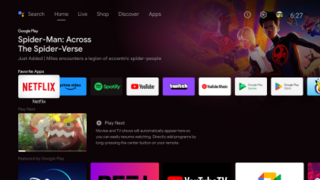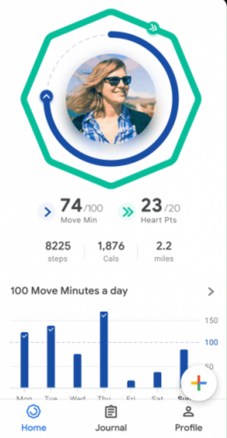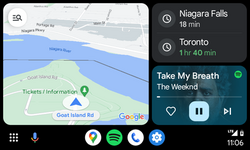
In-car entertainment (ICE), or in-vehicle infotainment (IVI), is a collection of hardware and software in automobiles that provides audio or video entertainment. In car entertainment originated with car audio systems that consisted of radios and cassette or CD players, and now includes automotive navigation systems, video players, USB and Bluetooth connectivity, carputers, in-car internet, and WiFi. Once controlled by simple dashboards knobs and dials, ICE systems can include steering wheel audio controls, handsfree voice control, touch-sensitive preset buttons, and even touch screens on higher-end units. Latest models of In-car entertainment systems are coming equipped with rear-view cameras along with side cameras for better safety.
Ford Sync is a factory-installed, integrated in-vehicle communications and entertainment system that allows users to make hands-free telephone calls, control music and perform other functions with the use of voice commands. The system consists of applications and user interfaces developed by Ford and other third-party developers. The first two generations run on the Windows Embedded Automotive operating system designed by Microsoft, while the third and fourth generations runs on the QNX operating system from BlackBerry Limited. Future versions will run on the Android operating system from Google.

Here Technologies is a Dutch multinational group specialized in mapping technologies, location data and related automotive services to individuals and companies. It is majority-owned by a consortium of German automotive companies and American semiconductor company Intel whilst other companies also own minority stakes. Its roots date back to U.S.-based Navteq in 1985, which was acquired by Finland-based Nokia in 2007. Here is currently based in The Netherlands.

Sygic is a Slovak company of global automotive navigation systems for mobile phones and tablets. The company was founded in 2004 and is headquartered in Bratislava, Slovakia. It became the first company to offer navigation for iPhone and second for Android. In 2015 Sygic reached milestone of 100 million downloads of its navigation app.

The Porsche Macan is a compact luxury crossover SUV (D-segment) produced by German manufacturer Porsche, a luxury car marque of Volkswagen Group, since February 2014. It is the smallest SUV from Porsche below the Cayenne.

Toyota Entune is an integrated multimedia navigation and telematics system for Toyota automobiles that provides satellite-based information on traffic, weather, sports scores, stocks, and fuel prices via subscription through SiriusXM. When connected to a compatible cellular phone running the Entune app via radio or USB cable, the system provided a browser and other apps including those from music services such as iHeartRadio, Pandora and XM Satellite Radio. The cell phone app supported iOS, Android, and Blackberry with different versions utilizing cell data. The system could be controlled with (limited) speech recognition, and optionally include the “Safety Connect” personalization system.
A connected car is a car that can communicate bidirectionally with other systems outside of the car. This connectivity can be used to provide services to passengers or to support or enhance self-driving functionality. For safety-critical applications, it is anticipated that cars will also be connected using dedicated short-range communications (DSRC) or cellular radios, operating in the FCC-granted 5.9 GHz band with very low latency.
MyLink a.k.a. Intellilink is a telematics system/infotainment system offered by General Motors in their vehicles. The system was debuted in 2011 in the then-new Chevrolet Volt.

CarPlay, or Apple CarPlay is an Apple standard that enables a car radio or head unit to be a display and controller for an iOS device. It is available on iPhone 5 and later models running iOS 7.1 or later.

Chromecast is a line of digital media players developed by Google. The devices, designed as small dongles, can play Internet-streamed audio-visual content on a high-definition television or home audio system. The user can control playback with a mobile device or personal computer through mobile and web apps that can use the Google Cast protocol, or by issuing commands via Google Assistant; later models introduced an interactive user interface and remote control. Content can be mirrored to video models from the Google Chrome web browser on a personal computer or from the screen of some Android devices.

Google Play Games is an online video gaming service by Google for Microsoft Windows, Chromebooks, and Android devices.

Android TV is a smart TV operating system based on Android and developed by Google. It is available on television sets, soundbars, set-top boxes and digital media players. A successor to Google TV, it features a user interface designed around content discovery and voice search, content aggregation from various media apps and services, and integration with other recent Google technologies such as Assistant, Cast, and Knowledge Graph.

Google Fit is a health-tracking platform developed by Google for the Android operating system, Wear OS, and iOS. It is a single set of APIs that blends data from multiple apps and devices. Google Fit uses sensors in a user's activity tracker or mobile device to record physical fitness activities, which are measured against the user's fitness goals to provide a comprehensive view of their fitness.

SmartDeviceLink consists of two distinct software elements: a core automotive piece which wraps in-vehicle services and integrates to the in-vehicle HMI, and a mobile proxy, which executes APIs to access and use services on the automotive head unit.
Automotive hacking is the exploitation of vulnerabilities within the software, hardware, and communication systems of automobiles.

The Google Assistant is a virtual assistant software application developed by Google that is primarily available on mobile and home automation devices. Based on artificial intelligence, The Google Assistant can engage in two-way conversations, unlike the company's previous virtual assistant, Google Now.

Fuchsia is an open-source capability-based operating system developed by Google. In contrast to Google's Linux-based operating systems such as ChromeOS and Android, Fuchsia is based on a custom kernel named Zircon. It publicly debuted as a self-hosted git repository in August 2016 without any official corporate announcement. After years of development, its official product launch was in 2021 on the first-generation Google Nest Hub, replacing its original Linux-based Cast OS.

Google Lens is an image recognition technology developed by Google, designed to bring up relevant information related to objects it identifies using visual analysis based on a neural network. First announced during Google I/O 2017, it was first provided as a standalone app, later being integrated into Google Camera but was reportedly removed in October 2022. It has also been integrated with the Google Photos and Google Assistant app and with Bard as of 2023.

Android Automotive is a variation of Google's Android operating system, tailored for its use in vehicle dashboards. Introduced in March 2017, the platform was developed by Google and Intel, together with car manufacturers such as Volvo and Audi. The project aims to provide an operating system codebase for vehicle manufacturers to develop their own version of the operating system. Besides infotainment tasks, such as messaging, navigation and music playback, the operating system aims to handle vehicle-specific functions such as controlling the air conditioning.















